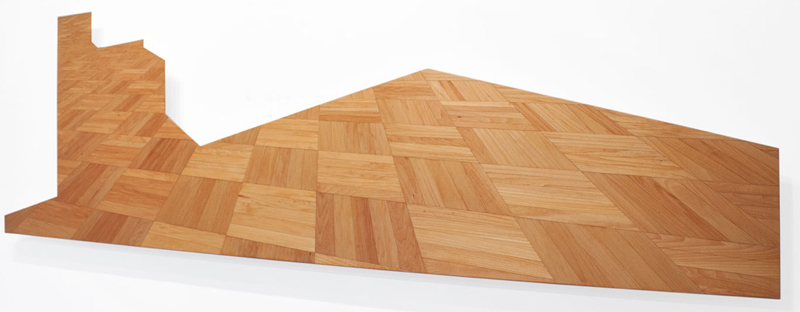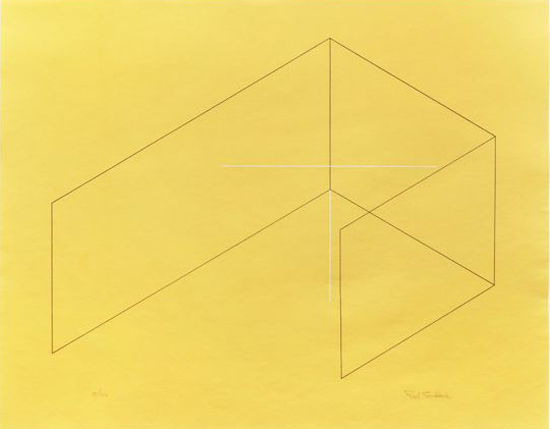One Wall, One Work: Walid Raad
Mira Dayal
August 2016

Walid Raad: Section 88: Views from inner to outer compartment_ACT VI_Scene II, 2013
Wood, 28 1/4 x 94 x 1 inches, © 2016 Walid Raad, image courtesy of Barbara Krakow Gallery
Section 88: Views from inner to outer compartment_ACT VI_Scene II (2013) continues Walid Raad’s interest in fictive spaces and critical geometries. At Barbara Krakow Gallery, it hangs alone, though there are several other works in the series. Even in his use of underscores rather than commas in the work’s title, invoking structured file names, Raad seems to play with a digital age. Indeed, though the wood sculpture is highly tactile, masterfully jointed to appear to be a wood floor receding into the distance, it also reads as a Photoshop mockup, rendered with the magnetic lasso tool to remove all walls and objects except for the floor. The inversion of the floor, a horizontal plane, into a polished vertical tableau is also reminiscent of the flattening of all spaces into a single viewer-oriented screen.
Because the perspective is so deep, it is easy to imagine the tiny slivers of wood continuing to splinter infinitely until they reach a vanishing point. But before they can reach that point, the wood patterns stop abruptly, having reached a horizontal line. Returning to the work’s title, Views from inner to outer compartment, one can imagine that the floor’s current endpoint is that next outer compartment. Where, then, is the viewer? Raad seems to have tricked the spectator into that inner compartment—or rather, he has helped the viewer realize that they were already in a compartment: that of the gallery. It then makes sense that Raad labels his work as if it were part of a play but includes onyl geometries in its construction. It is all scene, no action. The viewers are the actors.
 Fred Sandback, Untitled, 1970, Black and white silkscreen on yellow paper
Fred Sandback, Untitled, 1970, Black and white silkscreen on yellow paper
18 x 25 1/2 inches, image courtesy of Barbara Krakow Gallery
Looking around then to really see the gallery, one will see that despite there being “One Wall, One Work” in this show, there is also another work that seems to be in dialogue with Raad’s: Fred Sandback’s Untitled (1970), a silkscreen on yellow paper, also engages with perspectival space. Three “walls” are outlined in black, and at the midpoint of the intersection of the two farthest walls, a white T shape is outlined. It’s a classic optical illusion where, because the walls are transparent, the viewer could either be looking down onto the floor or looking up through it. Missing a fourth wall, the suggested space is another transparent compartment into which we might be confined; the work could have been the inspiration for Raad’s sculpture. The gallerist assures me it was not, but perhaps that’s all part of Raad’s fiction.
Barbara Krakow Gallery
10 Newbury Street Boston, MA
